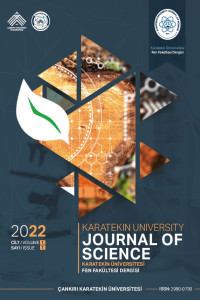Türk Çaylarının ve Çay Demlemelerinin Ağır Metal İçeriğinin Araştırılması
Türk çayları, çay demi, çay demleme süresi, demleme katkı maddeleri, ağır metaller
Investigation of Heavy Metal Content of Turkish Teas and Tea Infusions
Turkish tea, tea infusion, brewing period, brewing additives, heavy metals,
___
- Arora, N. K., Chauhan, R. (2021). Heavy metal toxicity and sustainable interventions for their decontamination. Environmental Sustainability 2021 4:1, 4(1), 1–3.
- Ashraf, W., Mian, A. A. (2008). Levels of selected heavy metals in black tea varieties consumed in Saudi Arabia. Bulletin of Environmental Contamination and Toxicology, 81(1): 101–104.
- Bolan, N. S., Adriano, D. C., Naidu, R. (2003). Role of phosphorus in (im)mobilization and bioavailability of heavy metals in the soil-plant system. Reviews of Environmental Contamination and Toxicology, 177: 1–44.
- Bolan, N. S., Choppala, G., Kunhikrishnan, A., Park, J., Naidu, R. (2013). Microbial transformation of trace elements in soils in relation to bioavailability and remediation. Reviews of Environmental Contamination and Toxicology, 225: 1–56.
- Corcho Alvarado, J. A., Balsiger, B., Röllin, S., Jakob, A., Burger, M. (2014). Radioactive and chemical contamination of the water resources in the former uranium mining and milling sites of Mailuu Suu (Kyrgyzstan). Journal of Environmental Radioactivity, 138: 1–10.
- Deshwal, G. K., Panjagari, N. R. (2020). Review on metal packaging: materials, forms, food applications, safety and recyclability". Journal of Food Science and Technology, 57(7): 2377–2392.
- Flaten, T. P. (2002). Aluminium in tea—concentrations, speciation and bioavailability. Coordination Chemistry Reviews, 228(2): 385–395.
- Gökmen, I. G., Birgül, O., Kence, A., Gökmen, A. (2005). Chernobyl radioactivity in Turkish tea and its possible health consequences. Journal of Radioanalytical and Nuclear Chemistry, 198(2): 487–497.
- Karimi, G. n.d. "Pharmacologyonline 3: 164-174 (2008). Newsletter Karimi et al. Concentrations and Health Risk of Heavy Metals in Tea Samples Marketed in IRAN Pharmacologyonline 3: 164-174 (2008) Newsletter Karimi et al".
- Leitenmaier, B., Küpper, H. (2013). Compartmentation and complexation of metals in hyperaccumulator plants. Frontiers in Plant Science, 4(SEP), 374.
- Liu, J., Lu, W., Zhang, N., Su, D., Zeer, L., Du, H., Hu, K. (2021). Collaborative assessment and health risk of heavy metals in soils and tea leaves in the southwest region of China. International Journal of Environmental Research and Public Health, 18(19): 10151.
- Matsushima, F., Meshitsuka, S., Nose, T. (1993). Contents of aluminum and manganese in tea leaves and tea infusions. Nihon EiseigakuZasshi. Japanese Journal of Hygiene, 48(4): 864–872.
- Mehra, A., Baker, C. L. (2007). Leaching and bioavailability of aluminium, copper and manganese from tea (Camellia sinensis). Food Chemistry, 100(4): 1456–1463.
- Neiva, A. M. R., Antunes, I. M. H. R., Carvalho, P. C. S., Santos, A. C. T. (2016). Uranium and arsenic contamination in the former Mondego Sul uranium mine area, Central Portugal. Journal of Geochemical Exploration, 162: 1–15.
- Nkansah, M. A., Opoku, F., Ackumey, A. A. (2016). Risk assessment of mineral and heavy metal content of selected tea products from the Ghanaian market. Environmental Monitoring and Assessment, 188(6): 1–11.
- Nugraha, E. D., Mellawati, J., Wahyudi, Kranrod, C., Makhsun, Tazoe, H., …Tokonami, S. (2022). Heavy Metal Assessments of Soil Samples from a High Natural Background Radiation Area, Indonesia. Toxics 2022, Vol. 10, Page 39, 10(1): 39.
- Nugraha, E. D., Wahyudi, K., Iskandar, D. (2019). Radon Concentrations in Dwelling of South Kalimantan, Indonesia. Radiation Protection Dosimetry, 184(3–4): 463–465.
- Salnikow, K., Zhitkovich, A. (2008). Genetic and epigenetic mechanisms in metal carcinogenesis and cocarcinogenesis: Nickel, arsenic, and chromium. Chemical Research in Toxicology, 21(1): 28–44.
- Schwalfenberg, G., Genuis, S. J., Rodushkin, I. (2013). The benefits and risks of consuming brewed tea: Beware of toxic element contamination. Journal of Toxicology, 2013.
- Seenivasan, S., Manikandan, N., Muraleedharan, N. N., Selvasundaram, R. (2008). Heavy metal content of black teas from south India. Food Control, 19(8): 746–749.
- U.S. tea market - statistics & facts | Statista. n.d. Retrieved December 21, (2022), from https://www.statista.com/topics/1513/tea-market/
- Wieczorek-Dabrowska, M., Tomza-Marciniak, A., Pilarczyk, B., Balicka-Ramisz, A. (2013). Roe and red deer as bioindicators of heavy metals contamination in north-western Poland. Http://Dx.Doi.Org/10.1080/02757540.2012.711322, 29(2): 100–110.
- Xu, J., Wang, S., Yao, T., She, X., Gan, Z. (2022). Vertical Distributions and Bioavailabilities of Heavy Metals in Soil in An-Tea Plantations in Qimen County, China. Processes, 10(4): 664.
- Yaylali-Abanuz, G., Tüysüz, N. (2009). Heavy metal contamination of soils and tea plants in the eastern black sea region, NE Turkey". Environmental Earth Sciences, 59(1): 131–144.
- Zhang, L., Zhang, J., Chen, L., Liu, T., Ma, G., Liu, X. (2018). Influence of manufacturing process on the contents of iron, copper, chromium, nickel and manganese elements in Crush, Tear and Curl black tea, their transfer rates and health risk assessment. Food Control, 89: 241–249.
- Başlangıç: 2022
- Yayıncı: Çankırı Karatekin Üniversitesi
Gama-kararsız Bölgede Kratzer Potansiyeli İçeren Bohr Hamiltoniyeninin Analitik Çözümü
Kırım-Kongo Kanamalı Ateşi (KKKA): Genel Bakış
Müge FIRAT, Mohammed Hussin HASHEMI, Mohammed Abd Ali DAWOD
Hilal Gökçe NALBANTOĞLU, Pınar ARSLAN
A~180 Civarındaki Çekirdeklerin Yapılarının Eşevreli Durum Yaklaşımı ile İncelenmesi
Ismael Shukur Ismael AL-BAYATİ
Türk Çaylarının ve Çay Demlemelerinin Ağır Metal İçeriğinin Araştırılması
Emine KUTLU, Ruken Esra DEMİRDÖĞEN
Alpsarı Göleti Havzasının (Çankırı) Morfometrik Özellikleri ve Arazi Kullanımı
